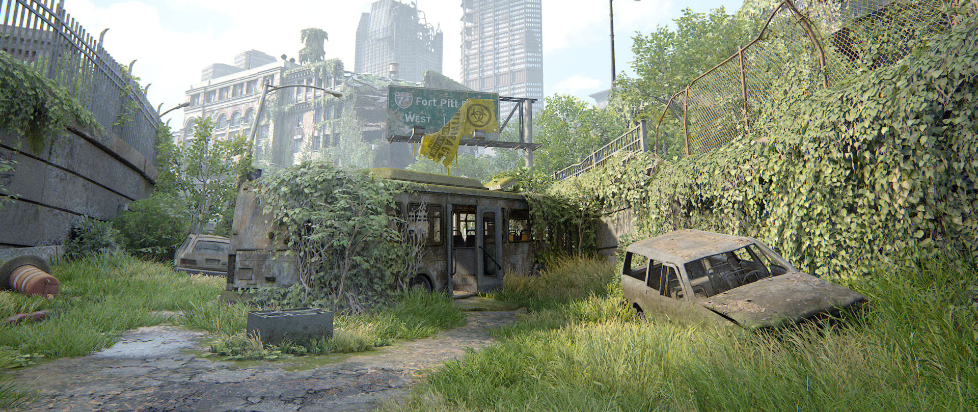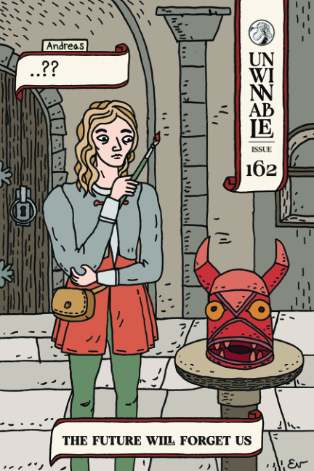
After Us

This column is a reprint from Unwinnable Monthly #162. If you like what you see, grab the magazine for less than ten dollars, or subscribe and get all future magazines for half price.
———
Architecture and games.
———
I finally got around to playing The Last of Us. I know, I’m at least a decade late on this one, but I couldn’t resist the remastered version, so I picked up a copy of the game, despite its obvious age. What stood out to me the most wasn’t the story or the gameplay, but the level design. Spend a while exploring the game world in The Last of Us and you’ll see all sorts of collapsing structures, overgrown vegetation and, of course, plenty of dirt and grime.
There’s a remarkably prevalent misconception to the effect that if people suddenly disappeared from the planet, the environment would eventually return to how it was before we started transforming the landscape. While this may not be completely false, meaning that yes, the planet could potentially recover, at least to some degree, the fact of the matter is that we’ve made substantial changes to the world around us, many of which could take centuries to fully heal and when they finally do, the scars will forever be unmistakable. You can see what I mean by taking a look at the landscape in countries like the United Kingdom, United States, China, Brazil and Mali. I’m not the first person to make these remarks, but with my background in landscape archaeology, I hope that I can bring a slightly new perspective to the matter.
Britain is well known for its rugged and beautiful landscapes, but what many people don’t understand is that most of them have been shaped and altered by centuries of animal grazing. Sheep and cattle in particular have left a profound impact on the vegetation and ecology of the country, changing the landscape in a variety of different ways.
The introduction of animal grazing can be traced back to the Neolithic Period when early farmers began to keep domesticated animals, mostly sheep and cows. These were used for their meat, milk and wool in addition to providing valuable fertilizer for crops. With the passage of time, the number of grazing animals increased and their impact on these landscapes became increasingly significant. Grazing animals feed on various plants including grass, heather and small shrubs. This led to overgrazing and a loss of vegetation, particularly on hillsides and other areas with steep slopes. The result was an especially bad form of soil erosion, something which in turn caused alterations in the landscape itself. The trampling of hooves for example led to soil compaction which left the landscape even more difficult for plants to grow. This led to the creation of bare patches of ground that only further intensified the ongoing soil erosion. While the landscape has mostly recovered through the tireless efforts of dedicated conservationists, many parts of the UK at this point are basically barren, despite being perfectly arable at one point in time.
Deforestation has had a significant impact on the landscape of Brazil, a country known for its lush rainforests and diverse ecosystems. While some of this has been caused by natural disasters like wildfires, much of the deforestation is the result of human activity, particularly agricultural expansion.
The most noticeable impact of deforestation in Brazil is the loss of forest cover. Brazil is home to the Amazon rainforest, the largest tropical rainforest in the world. This rainforest plays a critical role in regulating the climate, storing carbon and maintaining biodiversity, but over the past several decades, large areas of the Amazon have been cleared for agriculture, mining and other forms of industrial development. This led to a significant loss of forest cover, with devastating consequences for the environment like changes in the composition of the underlying soil. Trees play a crucial role in maintaining fertility as they help to retain moisture, prevent erosion and provide nutrients. When forests are cleared, the soil can become dry and compacted, making it really hard for plants to grow. This can lead to a decline in agricultural productivity as well as increased soil erosion and sedimentation in rivers and streams. Deforestation can also have an impact on the climate, something which has largely proven to be the case in Brazil. The trick is that trees absorb carbon dioxide as part of the process of photosynthesis. When they’re cut down or burned, the carbon stored in them is released into the atmosphere, contributing to global warming. Deforestation is estimated to be responsible for around ten percent of global greenhouse gas emissions.
The process of open-pit mining has already had a significant impact on the landscape in America, particularly in regions that are rich in mineral resources along the lines of coal, copper and gold. This type of mining involves removing large amounts of soil and rock to extract minerals, leaving behind deep pits.

One of the most noticeable impacts of open-pit mining is the creation of what are basically huge holes in the ground. These can be hundreds of feet deep and cover thousands of acres of land. They can drastically alter the appearance of a landscape, frequently resulting in barren, scarred earth where forests, grasslands or other ecosystems were once found. The removal of such large amounts of soil and rock also leads to soil erosion, something which can affect water quality and damage aquatic ecosystems. The chemicals used in the mining process often contaminate water sources and harm wildlife as well. When push comes to shove, the long-term effects of open-pit mining are not fully understood. When operations are finally complete, the site may be reclaimed and restored to some degree, but the landscape rarely makes a full recovery from the impact of this activity, particularly in terms of soil and ecosystem health. In some cases, abandoned mining sites can become environmental hazards, as chemicals and other pollutants leach into nearby water sources and the surrounding soil.
Urbanization has had a profound impact on the landscape in China. As one of the most populous countries in the world, China has experienced a rapid movement of people from rural to urban areas over the past several decades, with significant consequences for the environment, society and economy.
The most notable impact of urbanization in China would have to be the transformation of the rural into urban landscapes. When cities, towns and villages grow, they often wind up consuming the surrounding landscape, leading to a loss of natural habitat and farmland. This can have negative consequences for biodiversity and ecosystem health as well as agricultural productivity and food security. In addition to this loss of rural landscape, urbanization can also lead to significant environmental impacts in urban areas. As these increase in size, they often generate large amounts of waste and pollution, contributing to problems in terms of air and water quality, something which has plagued various parts of the country for decades. Urbanization can also lead to a depletion of natural resources, given that cities consume large amounts of electrical energy, fuel and water to support the population.
The landscape of Mali has been significantly impacted by the overuse of water reserves, especially in the Sahel region. The economy and society in Mali are heavily reliant on agriculture, with irrigation playing a key role in supporting crop production. The overuse of water reserves in the country has deeply impacted the environment, bringing agricultural activity to a standstill and costing countless people their livelihoods.
The depletion of ground and surface water resources in Mali would surely be among the worst impacts of water overuse. As farmers pump more and more water for irrigation, they slowly consume the country’s water reserves, depleting them faster than anyone can refill the reservoirs. This led to declining water tables, reduced flow and widespread drying up of wetlands over the years, negatively impacting the local ecosystems. The overuse of water resources also impacted agriculture, many farmers in the Sahel region relying on irrigation to support crop production, particularly during the dry season when rain-fed agriculture isn’t possible. When such water reserves are depleted, it becomes increasingly difficult and expensive for farmers to access water for irrigation, something which can lead to a decline in crop yields and ultimately food insecurity. In order to address the problem, several different approaches are being pursued, most notably sustainable water management practices like efficient irrigation techniques, water harvesting and improved water storage facilities, but decades worth of excessive use have resulted in significant impacts on the landscape and environment in Mali, rendering remediation a substantial challenge.
In a lot of ways, The Last of Us really isn’t a hopeful game, but at least in terms of the level design, there’s a little bit of light on the horizon. While the line of reasoning that our planet will eventually recover isn’t completely off the mark, the argument overlooks the true impact of our activities, blissfully ignoring the fact that such apparently innocuous activities like animal grazing and crop irrigation have already transformed the world around us. The landscape in places like the UK, US, China, Brazil and Mali today are completely different in comparison to what people would have seen in these parts of the planet only a few centuries ago. Something which needs to be kept in mind is that everything we do has an impact which may not be readily apparent, meaning that in order to create meaningful environmental change, we all have to do our part, even when it seems pretty pointless. In other words, please follow sustainable practices by recycling plastic and wood, conserving water and electricity, using public transit and especially making sure that your consumer goods come from good, ethical sources.
———
Justin Reeve is an archaeologist specializing in architecture, urbanism and spatial theory, but he can frequently be found writing about videogames, too. You can follow him on Twitter @JustinAndyReeve.




